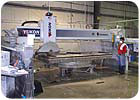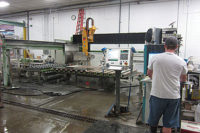
It is useful to utilize the gantry laser for templating. Depending on template material, the gantry laser can be used effectively for template alignment.
The backbone of your countertop fabrication operation is your bridge saw. Since it is typically at the beginning of your fabrication process, a bridge saw that is a bottleneck in your shop likely causes other downstream machinery and labor to sit idle in your facility. In essence, productivity of your bridge saw can affect the productivity of your entire shop.
Below are some suggestions to increase the efficiency of your saw station, including tips on running your saw at optimal capacity, determining the best area and position for the saw in your facility and reviewing steps to expedite the templating process.
Running your saw at optimal capacity
Your fabrication process and profitability begin at your bridge saw. It's important that your operators understand and utilize the full capabilities of your saw, and that begins with training. You should strive for at least three people in your facility that can serve as your bridge saw experts. If someone calls in ill, or you experience employee turnover, you won't be caught in a pinch.To have your saw running at optimal capacity, it's important you don't cut corners on tooling. Saving a few dollars by purchasing a cheaper blade may end up costing you thousands of dollars from inefficient or lost production. Make the investment and buy a blade that you can rely on, and experiment with different blades to understand what works best for your type of cutting. It may cost you a little more up front, but your equipment only works as good as the tooling you've placed on it.
It's important that you always have an extra blade in stock. You don't want to get caught in a situation where your blade needs to be replaced, and you need to order one from a supplier.
Each time you change blades, we recommend that you take time to dial-in your saw. In addition, it's important to dress each new blade to expose the diamond segments for efficient cutting. To dress your blade, get a scrap piece of sandstone or a cement block and step-cut the stone at higher feed rates with less water for a short period of time. Doing this will grind away the bonding material of the blade and will help expose the diamonds.
To extend the life of your blade, it's important that the blade is properly cooled. Periodically check that the waterforks are delivering adequate water to both sides of the blade. If the blade is not being cooled properly, the diamond segments will not wear away and glazing will occur. If you glaze a blade, follow the dressing process noted above to re-expose the diamond segments.

To extend the life of your blade, it's important that the blade is properly cooled. Periodically check that the waterforks are delivering adequate water to both sides of the blade.
All mechanical equipment requires general maintenance to prevent breakdowns, but sometimes maintenance gets overlooked or eliminated due to busy schedules. Spend time to review the saw manual, outline a preventive maintenance schedule for your bridge saw, and stick to it. By conducting preventive maintenance on your saw, you will be able to spot potential problems and will have time to take corrective action before the equipment causes you downtime, lost production and revenue.
Saw area in your facility
There are a number of things to consider when determining the best location for your bridge saw in the shop. First of all, it's important that your saw is close to your slab storage area. It is very inefficient and time consuming to have your slab storage far from your bridge saw. The less you have to move the stone, the more efficient you are.Give yourself extra space around your bridge saw for a layout station, and make sure that there is enough room for material movement from the bridge saw to the edging station. Whether you are using a crane, pallet jacks or a forklift, make sure that you have ample space to move material effectively and safely throughout your facility.
Focus on reducing the time to template
Did you know that the majority of fabricators spend about 80% of their time at the sawing station templating and only 20% cutting? There are great opportunities to increase saw productivity by decreasing the time spent on templating. Here are some hints to improve your cutting-to-templating ratio:- Create a dedicated layout station area apart from your sawing table. While your saw is cutting one job, someone else can be preparing another slab of stone.
- Consider installing two tables under your saw. The idea is the same as a dedicated lay-out station. A dual-table saw allows the operator to cut stone on one table as material on the other table is being templated for the next job.
- Utilize the gantry laser for templating. Depending on template material, the gantry laser can be used effectively for template alignment.
- Reduce the number of cuts. By lining the first cut on the clean cut line, you can reduce the number of cuts needed, saving you time. A good example of this would be making long straight cuts, like a kitchen counter followed by the matching backsplash.
- Cut extra backsplash pieces. Often, there is extra stone leftover from a slab. Rather than adding it to your trash bin, consider cutting a few extra pieces of backsplash, a common piece that breaks during transportation. The few minutes spent cutting the extra backsplash pieces now will be much less disruptive than finding that scrap piece of stone to use later.
To summarize, bridge saw efficiently boils down to:
- Proper operator training
- Proper tooling selection and care
- Proper machine adjustment and maintenance
- Efficient shop layout
- Minimizing non-cutting time with efficient template and cutting techniques
